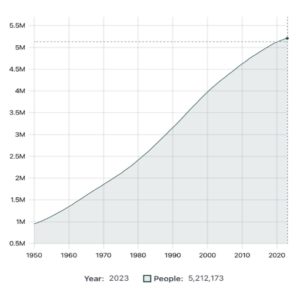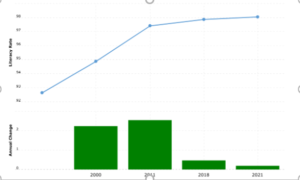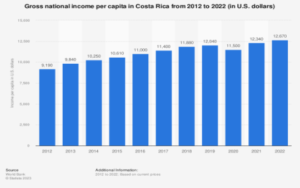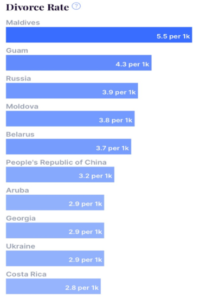Population and Demographic:
Costa Rica is home to various Indigenous Peoples, constituting 2.4% of the population. As of July 2023, the country’s total population is around 5.2 million, with 82.04% residing in urban areas, notably San Jose (Indigenous Peoples in Costa Rica, 2023). The European ancestry dominates at 83.6%, followed by mulattoes 6.7%, Native Americans 2.7%, and black or Afro-Caribbeans 1.1% (Quesada, 2020). Spanish is the primary language, and the population has been steadily increasing over the years, as shown in Figure 3.
Figure 3
Historic Population Density of Costa Rica (1950-2023)
Gender: Costa Rica’s population exhibits an equal gender distribution, with 50% females and 50% males. The median age is 32 years, and the population is divided into 21.49% under 14, 68.59% aged 15-64, and 9.92% aged 65 and over. The overall life expectancy is 80 years, with females expected to live longer, 82 years, than males, 77 years. Figures 4 and 5 visually represent age groups and life expectancy trends over decades. (World Factbook, 2023).
Figure 4
Population by Age & Sex
Figure 5
Life Expectancy in Costa Rica from 1955 to 2023
Literacy: Costa Rica demonstrates impressive success in education, with enrollment rates rising from 2010 to 2022. Primary education boasts a 100% rate, lower secondary is at 96%, and upper secondary education is at 92% (UNFPA Costa Rica, 2023). The country’s literacy rate for ages 15 and above exceeds 98%, with a slight increase from 2018 to 2021. In 2000, the literacy rate was 94.87%, growing to 97.41% by 2010, showcasing substantial progress in just a decade (Costa Rica Literacy Rate 1984-2023, 2023). Figure 6 illustrates the significant growth in literacy rates throughout the decades. For individuals ages 15 and over, 98.1% of females and 98% of males exhibit strong literacy skills (The World Factbook, 2021), highlighting an equal distribution of literacy between women and men in Costa Rica. It is safe to say that there is an even amount between the women and men of Costa Rica who have good literacy skills and knowledge.
Figure 6
Costa Rica Literacy Rate 1984-2023
Income & Social Class: Understanding a country’s social classes is crucial for insights into people’s behavior, attributes, knowledge, and lifestyle. Costa Rica, identified as an upper-middle-class country with notable development achievements (The World Bank in Costa Rica, 2023), exhibits an average household income of USD 16,517 per year after taxes. Employment rates for those aged 15 to 64 are at 55%, with 68% of men and 41% of women engaged in paid occupations (Better Life Index, 2023). In 2022, the national gross income per capita rose by $330, a 2.67% increase from 2021, reaching a peak of $12,670 (Statista, 2023). Figure 7 illustrates a slight growth in per capita income in Costa Rica from 2021 to 2022.
Figure 7
Gross National Income Per Capita in Costa Rica From 2012 to 2022 (in U.S. Dollars)
Marriage: Costa Rican marriage has shifted due to increased education and employment opportunities for women. As a result, the average age at which Costa Ricans start their families has been postponed, contributing to a decline in the fertility rate (Van Velzer, 2023). The country has strict laws in place to ensure that fathers are financially responsible for their children, regardless of marital status (Grossman, 2021). The number of singles was at its highest, 53%, while the marital status was at its lowest at just 19.7% in 2018 (Rosero-Bixby, 2023). However, the country has the highest divorce rates, estimated at 2.8 per 1,000 people (Divorce Rate by Country, 2023). Costa Rica is one of the top ten countries with the highest rank of divorce rates (Rosero-Bixby, 2023). As an illustration, the graph in Figure 8 proves that Costa Rica is one of the top ten countries with the highest divorce rates.
Figure 8.
Divorce Rates Among Countries.








